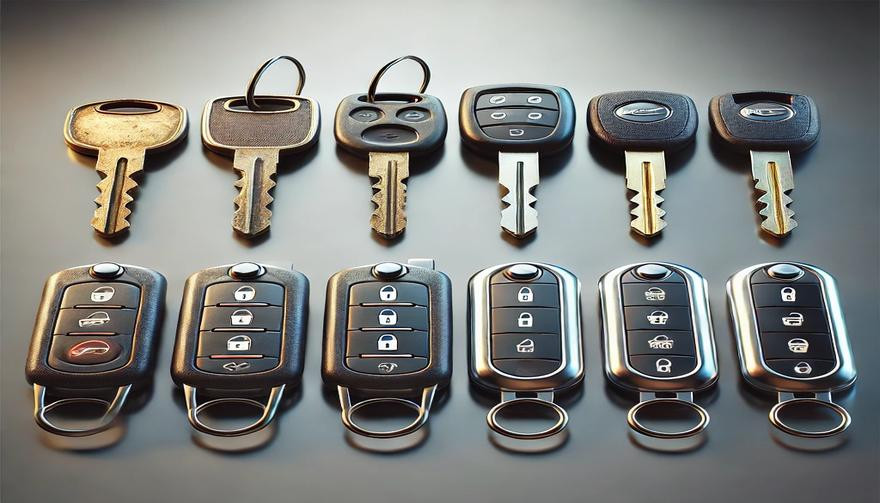Car keys have come a long way from simple metal tools to advanced digital systems. This evolution reflects the advancements in automotive security, convenience, and technology. Understanding the history of car keys gives you a better appreciation of the tools you use to unlock, start, and secure your vehicle. Here’s a look at how car keys have transformed over the years.
1. The Humble Beginnings: Metal Keys
The story of car keys began with simple, unassuming metal keys designed to manually lock and unlock car doors.
- How They Worked: These keys were physical tools that matched a mechanical lock’s configuration.
- Challenges: Lost keys or broken locks often required professional locksmiths for replacements or repairs.
- Impact: Metal keys, while functional, offered little in terms of advanced security or convenience.
Though basic, these keys laid the groundwork for innovations to come.
2. Entering the Electronic Era: Remote Keys
The next big leap in car key evolution came with the introduction of remote keys in the 1980s. These keys added a layer of convenience and functionality.
- Features:
- Remote locking and unlocking.
- Panic buttons for emergencies.
- Integration with car alarms for added security.
- Advantages: No more fumbling for locks in the dark; a simple press of a button provided instant access.
- Drawbacks: Batteries needed frequent replacement, and repairs were more complex than with traditional metal keys.
Remote keys quickly became a standard feature for modern vehicles.
3. The Smart Key Revolution
By the late 1990s and early 2000s, smart keys emerged, transforming how you interacted with your car.
- How They Worked: These key fobs used radio signals to communicate with your car, allowing for keyless entry and push-button starts.
- Benefits:
- Enhanced security with encrypted signals.
- Increased convenience with no need to insert a key into the ignition.
- Sophisticated design and compact form factors.
- Limitations: These keys are expensive to replace and require professional programming.
Smart keys brought unparalleled convenience but also increased the need for specialized services in case of loss or damage.
4. Integration with Smartphones: Digital Keys
In recent years, car key technology has embraced the smartphone revolution, allowing you to unlock and start your car using your mobile device.
- Features:
- App-based controls for locking, unlocking, and starting your car.
- Sharing access with family or friends via the app.
- Enhanced security with biometric verification like fingerprints or face recognition.
- Advantages: No physical key needed, making it harder to lose or forget.
- Considerations: Dependence on phone battery life and app reliability.
Digital keys represent the cutting edge of car key technology, blending convenience with advanced security features.
5. Biometric Car Keys: The Future of Security
Biometric keys are poised to redefine vehicle access with unmatched security and personalization.
- How They Work: These systems rely on fingerprint or facial recognition to verify the user’s identity.
- Benefits:
- Impossible to replicate or hack.
- Fully personalized access.
- Enhanced theft protection.
- Challenges: High development costs and limited availability in mainstream vehicles.
Biometric keys are still in their infancy but hint at a future where cars are more secure than ever.
6. Why Understanding Key Evolution Matters
Knowing how car keys have evolved helps you make informed decisions when it’s time to replace or upgrade.
- Cost Considerations: From simple metal keys to advanced digital systems, replacement costs vary significantly.
- Security Features: Understanding the security features of your key can help you prevent theft and unauthorized access.
- Convenience: Opt for a system that matches your lifestyle, whether it’s a traditional key or an app-based digital solution.
The more you know, the better equipped you are to choose the right key for your vehicle.
Pro Tips for Key Replacement and Maintenance
- Backup Keys: Always keep a spare key in a safe location.
- Battery Checks: Replace key fob batteries regularly to avoid sudden malfunctions.
- Professional Help: Seek professional assistance for programming smart or digital keys.
- Protect Your Keys: Use a key cover to prevent wear and tear.
Proper maintenance ensures your car key remains functional and reliable for years to come.
From the simplicity of metal keys to the sophistication of biometric access, car key technology continues to evolve. Each advancement brings greater security, convenience, and innovation, making life easier for car owners like you. Whether you’re replacing a key or exploring the latest tech, understanding this evolution helps you stay ahead in the world of automotive technology.


 (1) (1)_1741789339.jpg)
_1743422904.jpg)
 (1)_1737723462.jpg)
_1742479499.jpg)